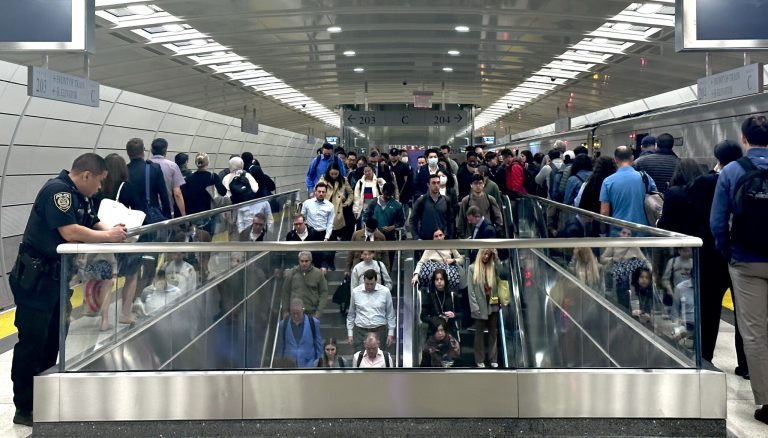
After much anticipation and more than a decade in delays, Grand Central Madison Terminal opened for full-service Feb. 27 and the Long Island Rail Road finally brought commuters to Manhattan’s East Side.
While commuters who work closer to Grand Central rejoiced, many Penn Station commuters have spoken out against the schedule changes, which many say have negatively impacted their commute, an essential aspect of their day.
Blank Slate Media’s Cameryn Oakes rode the LIRR Port Washington line for the Monday morning commute into Grand Central Madison to speak to commuters about how the new schedule had affected their trip and experience it for herself, the second part of a series on riding the LIRR.
Grand Central began full LIRR service Feb. 27 with a revised schedule that added trains running into Grand Central to its regular Penn Station service, which was also changed.
Andrew Scandalios, a Port Washington commuter for 20 years, said he works near Grand Central and that the additional station has made his commute better by diminishing travel times. While he said commute times have been shorter, they are still longer than those going to Penn Station.
The partially express train running to Grand Central is about a 43-minute ride. The express trains running to Penn Station are about 36 minutes long.
Scandalios said that he would like to see more express trains running into Grand Central to diminish the commute time.
Grievances for Penn Station commuters include fewer express trains, longer wait times in between trains and extended commute times overall.
Trains running to and from Penn Station were reduced under the new schedule in order to reroute trains to Grand Central instead.
The schedule also cut the number of express trains running along the Port Washington branch after the MTA originally proposed that all would be eliminated.
Under the current schedule, the only express trains running out of Port Washington go into Penn Station and none to Grand Central. The three express trains during the morning rush only stop at three stations – Plandome, Manhasset and Great Neck – before arriving on the West Side of Manhattan.
Three trains run partially express into Grand Central, making six stops after leaving Port Washington. At Bayside, the sixth stop, the train then runs express to Woodside where it makes its final stop before arriving on the East Side.
The 7:17 a.m. train leaving Port Washington is one of the three trains that run partially express into Grand Central, sandwiched between the other two leaving at 6:47 a.m. and 8:14 a.m.
The 7:17 a.m. train is scheduled to arrive in Grand Central at 8 a.m. and is the only train that arrives substantially before the 9 a.m. workday start time. While the 8:14 a.m. train arrives in Grand Central at 8:57 a.m., this may not give commuters enough time to arrive at work by 9 a.m.
Richard Class, a Port Washington commuter for 40 years, said that the addition of Grand Central Madison has made his commute to his job on the Upper East Side much easier than when he commuted into Penn Station.
He said that while the trains are typically on time, when they aren’t, it can be a big issue.
“When it goes bad, it’s really, really bad,” Class said. “It’s miserable.”
The MTA’s Train Time app, which provides the train schedules for all LIRR and Metro-North trains as well as online ticket sales, includes a feature that tracks the occupancy of each train car.
The app describes each car on the train with the number of occupants and a color associated with the percentage of seats taken. Colors range from green, yellow, orange and red, each respectively associated with fewer than 35%, 35-50%, 50-85% and over 85% of seats taken.
The 7:17 a.m. train to Grand Central train was made up of 10 M7 rail cars, which use the train’s suspension systems to measure the weight of each car’s seating cabin and approximate occupancy, according to the MTA.
Included were five A cars and five B cars. A cars have a maximum occupancy of 110 passengers and B cars, which include a handicap-accessible bathroom, have a maximum occupancy of 101 passengers.
The train’s total maximum occupancy was 1,055 passengers.
Upon leaving Port Washington, all but one train car was at less than 35% capacity. These cars had from 5 to 33 passengers. One train car contained an estimated 36 passengers, being the only within the 35-50% occupancy range.
The train continued to fill with passengers as it picked up more along the way to Grand Central. Upon arrival in Manhattan, all train cars ranged from 35-85% occupancy based on the app’s determination.

Five cars stayed within the 35-50% occupancy range. The other five cars were classified in the 50-85% range, with the largest occupancy in a single car estimated at 69 passengers.
About 522 passengers arrived in Grand Central Madison at 7:57 a.m., arriving three minutes earlier to their destination. The train’s total occupancy upon arrival to the East Side was just shy of 50%.
Commuters arrived at the sleek new terminal’s platform, which is on the station’s lower level and services eight tracks. Steep escalators take commuters up to the concourse level, which features wide arching walkways and art installations from renowned artists, including Yayoi Kusama.
While the morning commute ran smoothly, Port Washington commuter Class said what is more annoying is the commute home. He said trains run less frequently, meaning he has to wait longer for another train in the instance that he misses one.
For someone who gets off work at 5 p.m., the next train departing from Grand Central that runs directly to Port Washington leaves at 5:21 p.m. The following one leaves at 5:42 p.m. but does not go to Port Washington, requiring commuters to transfer. The next train after the 5:21 p.m. departure that arrives in Port Washington is not until 6:08 p.m.






